Afghanistan's authorities are trying to tackle pollution in the country's capital, which may be even deadlier than the 18-year-old war.
There are no official statistics on how many Afghans die of pollution-related illnesses, but the research group State of Global Air said more than 26,000 deaths could be attributed to air pollution in 2017, compared to 3,483 civilians killed that year in the Afghan war.
Click to Gallery
Afghanistan's authorities are trying to tackle pollution in the country's capital, which may be even deadlier than the 18-year-old war.
Decades of war have wrecked the city's infrastructure and caused waves of displaced people. Their camps are surrounded by garbage dumps, with no proper water or sanitation system.
In this Wednesday, Oct. 16, 2019. photo, smoke comes out from silencer of an old mini-bus in Kabul, Afghanistan. Authorities are trying to tackle pollution in the country’s capital, which may be even deadlier than 18-year-old war. Most days a layer of smog covers Kabul, and it gets worse in the winter, when people burn coal, garbage, plastic and rubber to heat their homes. (AP PhotoRahmat Gul)
In this Oct. 15, 2019 photo, Afghan children receive treatment for respiratory problems at a pediatric hospital, in Kabul, Afghanistan. Afghanistan’s authorities are trying to tackle pollution in the country’s capital, which may be even deadlier than 18-year-old war. The research group State of Global Air said more than 26,000 deaths could be attributed to air pollution in 2017, compared to 3,483 civilians killed that year in the Afghan war. (AP PhotoRahmat Gul)
In this Oct. 23, 2019 photo, trucks unload garbage at the Kabul Municipality dump yard, on the outskirts of Kabul, Afghanistan. Authorities are trying to tackle pollution in the country’s capital, which may be even deadlier than 18-year-old war. Most days a layer of smog covers Kabul, and it gets worse in the winter, when people burn coal, garbage, plastic and rubber to heat their homes. (AP PhotoRahmat Gul)
In this Oct. 29, 2019 photo, a woman who fled with her husband Yousuf and family from their home in eastern Afghanistan, burns plastic to make tea at a camp for displaced people, in Kabul, Afghanistan. The pollution may be even deadlier than Afghanistan’s war, now 18 years long. There are no official statistics on how many Afghans die of pollution-related illnesses, but the research group State of Global Air said more than 26,000 deaths could be attributed to it in 2017. (AP PhotoRahmat Gul)
In this Oct. 16, 2019 photo, smoke comes out from the exhaust pipe of an old mini-bus in Kabul, Afghanistan. Authorities are trying to tackle pollution in the country’s capital, which may be even deadlier than 18-year-old war. Most days a layer of smog covers Kabul, and it gets worse in the winter, when people burn coal, garbage, plastic and rubber to heat their homes. (AP PhotoRahmat Gul)
In this Wednesday, Oct. 23, 2019 photo, loaders work at the Kabul Municipality dump yard on the outskirts of Kabul, Afghanistan. Authorities are trying to tackle pollution in the country’s capital, which may be even deadlier than 18-year-old war. Most days a layer of smog covers Kabul, and it gets worse in the winter, when people burn coal, garbage, plastic and rubber to heat their homes. (AP PhotoRahmat Gul)
In this Oct. 23, 2019 photo, Abdul Basir Akhundzada head of Kabul municipality garbage dump yard, walks at garbage dump yard on the outskirts of Kabul, Afghanistan. Kabul, a city of some 6 million, has become one of the most polluted cities in the world, as decades of war have wrecked infrastructure and caused waves of displaced people. Authorities are trying to tackle pollution in the country’s capital, which may be even deadlier than 18-year-old war. (AP PhotoRahmat Gul)
In this Oct. 15, 2019 photo, an Afghan child receives treatment for respiratory problems at a pediatric hospital, in Kabul, Afghanistan. Kabul, a city of some 6 million, has become one of the most polluted cities in the world, as decades of war have wrecked infrastructure and caused waves of displaced people. Authorities are trying to tackle pollution in the country’s capital, which may be even deadlier than 18-year-old war. (AP PhotoRahmat Gul)
In this Oct. 15, 2019 photo, Nargis Mohmand, Kabul Municipality's spokeswoman, gives an interview to The Associated Press in Kabul, Afghanistan. Kabul, a city of some 6 million, has become one of the most polluted cities in the world, as decades of war have wrecked infrastructure and caused waves of displaced people. Authorities are trying to tackle pollution in the country’s capital, which may be even deadlier than 18-year-old war. (AP PhotoRahmat Gul)
Most days a layer of smog covers Kabul, a city of some 6 million, and it gets worse in the winter, when people burn coal, garbage, plastic and rubber to heat their homes in the bitter cold.
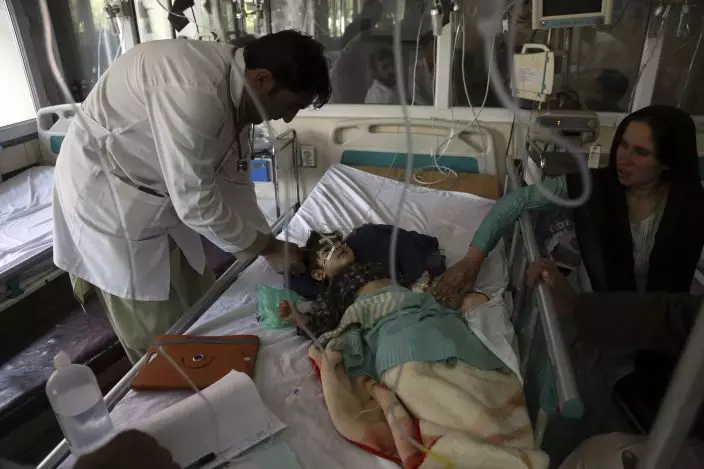
In this Oct. 15, 2019 photo, an Afghan girl receives treatment for respiratory problems at a pediatric hospital, in Kabul, Afghanistan. Afghanistan’s authorities are trying to tackle pollution in the country’s capital, which may be even deadlier than 18-year-old war. The research group State of Global Air said more than 26,000 deaths could be attributed to air pollution in 2017, compared to 3,483 civilians killed that year in the Afghan war. (AP PhotoRahmat Gul)
Decades of war have wrecked the city's infrastructure and caused waves of displaced people. Their camps are surrounded by garbage dumps, with no proper water or sanitation system.
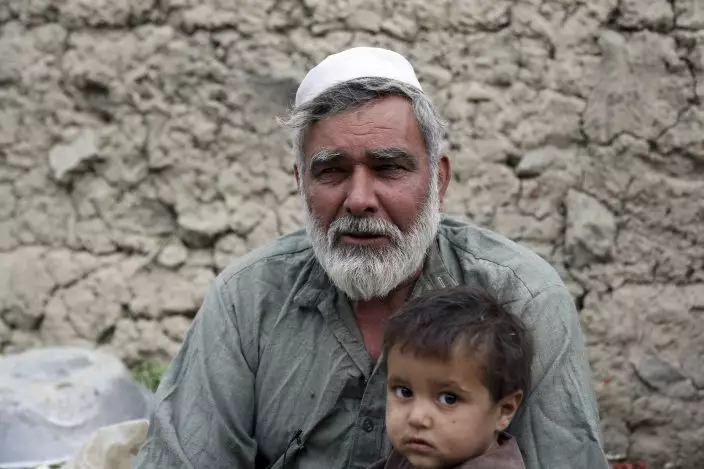
In this Oct. 29, 2019 photo, Yusouf, who escaped war in eastern Afghanistan to safeguard his family, speaks during an interview in Kabul, Afghanistan. In the capital, Kabul, five of his children died, not from violence or bombings, but from air pollution, worsened by bitter cold and poverty. (AP PhotoRahmat Gul)
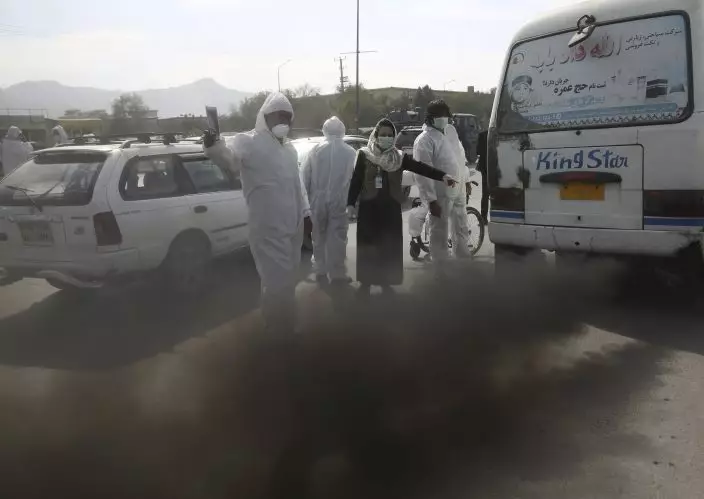
In this Wednesday, Oct. 16, 2019. photo, smoke comes out from silencer of an old mini-bus in Kabul, Afghanistan. Authorities are trying to tackle pollution in the country’s capital, which may be even deadlier than 18-year-old war. Most days a layer of smog covers Kabul, and it gets worse in the winter, when people burn coal, garbage, plastic and rubber to heat their homes. (AP PhotoRahmat Gul)
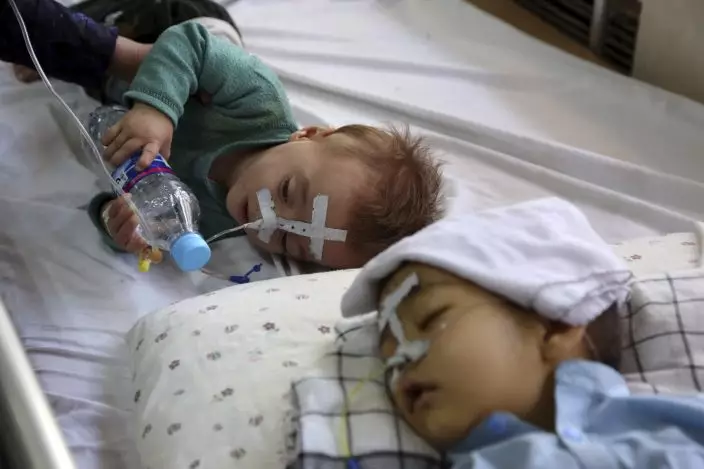
In this Oct. 15, 2019 photo, Afghan children receive treatment for respiratory problems at a pediatric hospital, in Kabul, Afghanistan. Afghanistan’s authorities are trying to tackle pollution in the country’s capital, which may be even deadlier than 18-year-old war. The research group State of Global Air said more than 26,000 deaths could be attributed to air pollution in 2017, compared to 3,483 civilians killed that year in the Afghan war. (AP PhotoRahmat Gul)
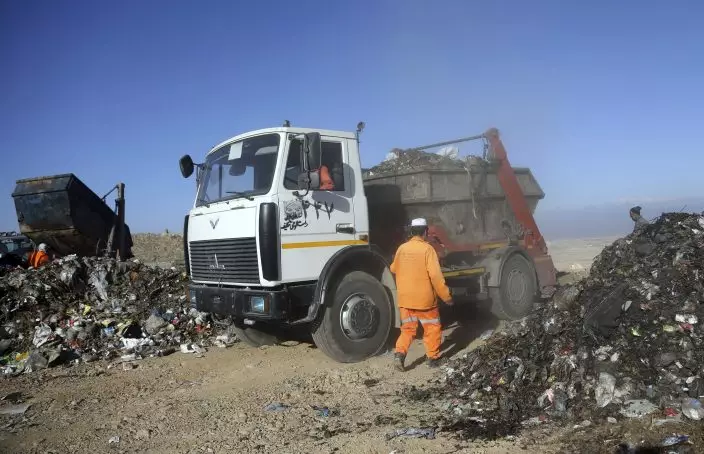
In this Oct. 23, 2019 photo, trucks unload garbage at the Kabul Municipality dump yard, on the outskirts of Kabul, Afghanistan. Authorities are trying to tackle pollution in the country’s capital, which may be even deadlier than 18-year-old war. Most days a layer of smog covers Kabul, and it gets worse in the winter, when people burn coal, garbage, plastic and rubber to heat their homes. (AP PhotoRahmat Gul)
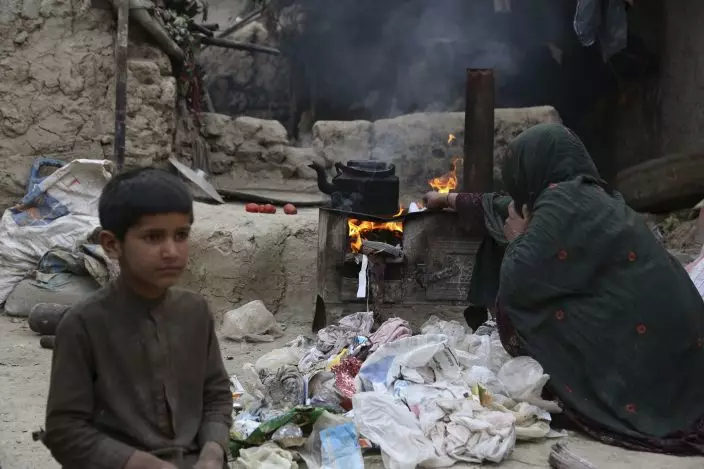
In this Oct. 29, 2019 photo, a woman who fled with her husband Yousuf and family from their home in eastern Afghanistan, burns plastic to make tea at a camp for displaced people, in Kabul, Afghanistan. The pollution may be even deadlier than Afghanistan’s war, now 18 years long. There are no official statistics on how many Afghans die of pollution-related illnesses, but the research group State of Global Air said more than 26,000 deaths could be attributed to it in 2017. (AP PhotoRahmat Gul)
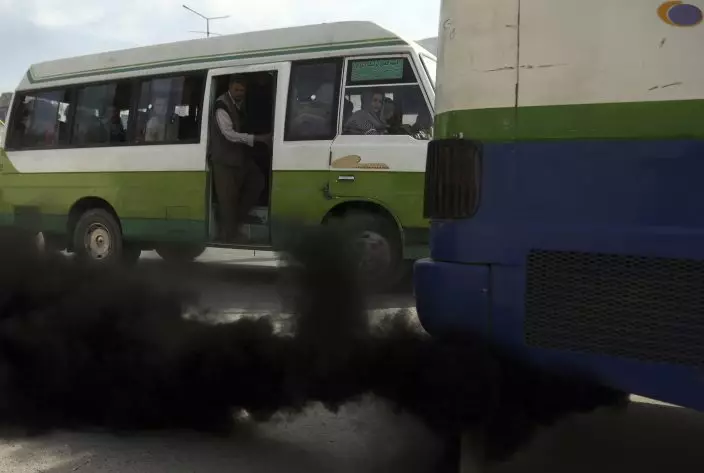
In this Oct. 16, 2019 photo, smoke comes out from the exhaust pipe of an old mini-bus in Kabul, Afghanistan. Authorities are trying to tackle pollution in the country’s capital, which may be even deadlier than 18-year-old war. Most days a layer of smog covers Kabul, and it gets worse in the winter, when people burn coal, garbage, plastic and rubber to heat their homes. (AP PhotoRahmat Gul)
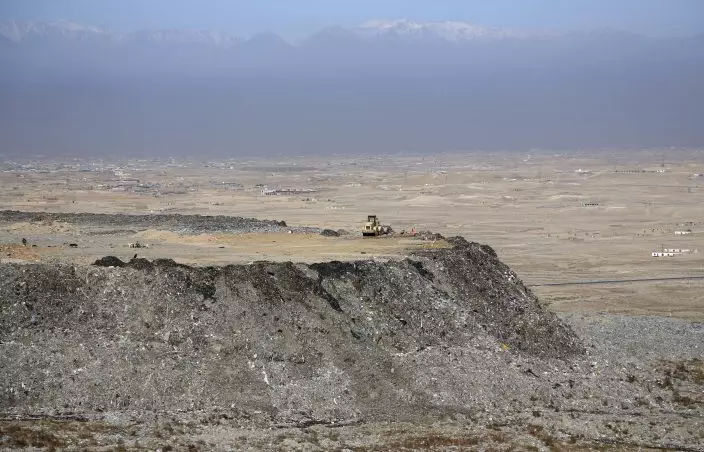
In this Wednesday, Oct. 23, 2019 photo, loaders work at the Kabul Municipality dump yard on the outskirts of Kabul, Afghanistan. Authorities are trying to tackle pollution in the country’s capital, which may be even deadlier than 18-year-old war. Most days a layer of smog covers Kabul, and it gets worse in the winter, when people burn coal, garbage, plastic and rubber to heat their homes. (AP PhotoRahmat Gul)
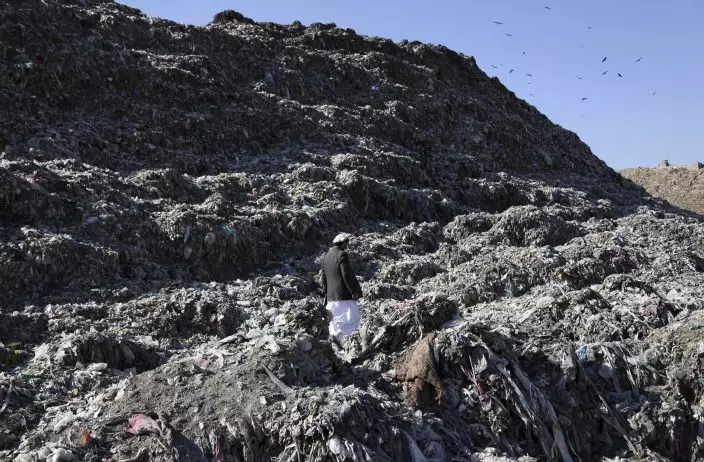
In this Oct. 23, 2019 photo, Abdul Basir Akhundzada head of Kabul municipality garbage dump yard, walks at garbage dump yard on the outskirts of Kabul, Afghanistan. Kabul, a city of some 6 million, has become one of the most polluted cities in the world, as decades of war have wrecked infrastructure and caused waves of displaced people. Authorities are trying to tackle pollution in the country’s capital, which may be even deadlier than 18-year-old war. (AP PhotoRahmat Gul)

In this Oct. 15, 2019 photo, an Afghan child receives treatment for respiratory problems at a pediatric hospital, in Kabul, Afghanistan. Kabul, a city of some 6 million, has become one of the most polluted cities in the world, as decades of war have wrecked infrastructure and caused waves of displaced people. Authorities are trying to tackle pollution in the country’s capital, which may be even deadlier than 18-year-old war. (AP PhotoRahmat Gul)

In this Oct. 15, 2019 photo, Nargis Mohmand, Kabul Municipality's spokeswoman, gives an interview to The Associated Press in Kabul, Afghanistan. Kabul, a city of some 6 million, has become one of the most polluted cities in the world, as decades of war have wrecked infrastructure and caused waves of displaced people. Authorities are trying to tackle pollution in the country’s capital, which may be even deadlier than 18-year-old war. (AP PhotoRahmat Gul)
DETROIT (AP) — The Oakland Athletics no longer have to wonder where they'll play the next few seasons. That won't make the long goodbye any easier.
The A's reacted to the announcement that this will be their last year in Oakland with a mixture of sadness and relief.
“At least as a player, you know where you’re headed,” outfielder Seth Brown said Friday before a game against the Tigers in Detroit. “There’s obviously a lot of moving parts, a lot of stuff we’re not privy to, so it’s just been kind of a waiting game on our end. Where are we going to go? Where are we going to be? So I think just having that knowledge -- at least we know where we’re going to be playing next year.”
Vivek Ranadivé, who owns the Triple-A Sacramento River Cats, and Oakland Athletics owner John Fisher announced Thursday that the A’s will temporarily relocate to West Sacramento's Sutter Health Park for at least three seasons. The A's are moving to Las Vegas after a new ballpark is constructed.
The River Cats, who are affiliated with the San Francisco Giants, will continue to play at the same facility.
Fisher was unable to reach an agreement with Oakland city officials on extending the lease at Oakland Coliseum, which expires at the end of this season. The A's have played in the city since 1968.
“There's direction now, which we've talked a lot about,” Oakland A's manager Mark Kotsay said. “We've got time to kind of reflect on what this really means from an organizational standpoint, the history that we've had in Oakland, with this being now the final season. There's a lot of emotion that goes behind this.”
It will not only cause some upheaval for the players and staff but also members of the organization that work behind the scenes.
“At the end of the day, we know where we're going to be for the next three seasons after the finish this year and that in itself gives a little bit of stability,” Kotsay said. “At the same time, in the present, it's challenging in certain ways to think about the finality of this organization in Oakland.”
Sacramento will be a much smaller environment to house a major league team. Ranadivé said the River Cats venue currently seats 16,000 when counting the stands, the lawn behind center field and standing room only.
First baseman Ryan Noda is concerned with the facilities. He's hopeful that significant upgrades will be made, much like the Toronto Blue Jays did at Buffalo's Triple-A facility. The Blue Jays played at Buffalo's Sahlen Field in 2020 in 2021 during the COVID-19 pandemic.
“New walls, new dugouts, new locker rooms — everything they needed to become a big league stadium,” said Noda, who played some games in Sacramento as a minor leaguer. “As long as we can do something like that, then it'll be all right. But it's definitely going to be different than playing in stadiums that hold 40,000 people.”
Kotsay is confident the upgrades will occur.
“I know it will be of major league baseball quality,” he said. “It's has to be of major league baseball quality. I know the Players Association will make sure that takes place, as they did in Buffalo.”
For the rest of this season, the A's will have to deal with small home crowds and disappointed fans.
“We’re sad for the fans, the diehard fans, who always come to our games, always support us, always support the boys wearing the jersey,” Noda said.
AP MLB: https://apnews.com/hub/mlb

Sacramento Kings owner Vivek Ranadive, center, shakes hands John Fisher, owner of the Oakland Athletics, before the start of a news conference where Fisher announced his team will leave Oakland after this season and play temporarily at a minor league park, during a news conference in West Sacramento, Calif., Thursday, April 4 2024.The A's announced the decision to play at the home of the Sacramento River Cats from 2025-27 with an option for 2028 on Thursday after being unable to reach an agreement to extend their lease in Oakland during that time. (AP Photo/Rich Pedroncelli)

John Fisher, owner of the Oakland Athletics baseball team, announces that his team will leave Oakland after this season and play temporarily at a minor league park, during a news conference in West Sacramento, Calif., Thursday, April 4, 2024. The A's announced the decision to play at the home of the Sacramento River Cats from 2025-27 with an option for 2028 on Thursday after being unable to reach an agreement to extend their lease in Oakland during that time. (AP Photo/Rich Pedroncelli)
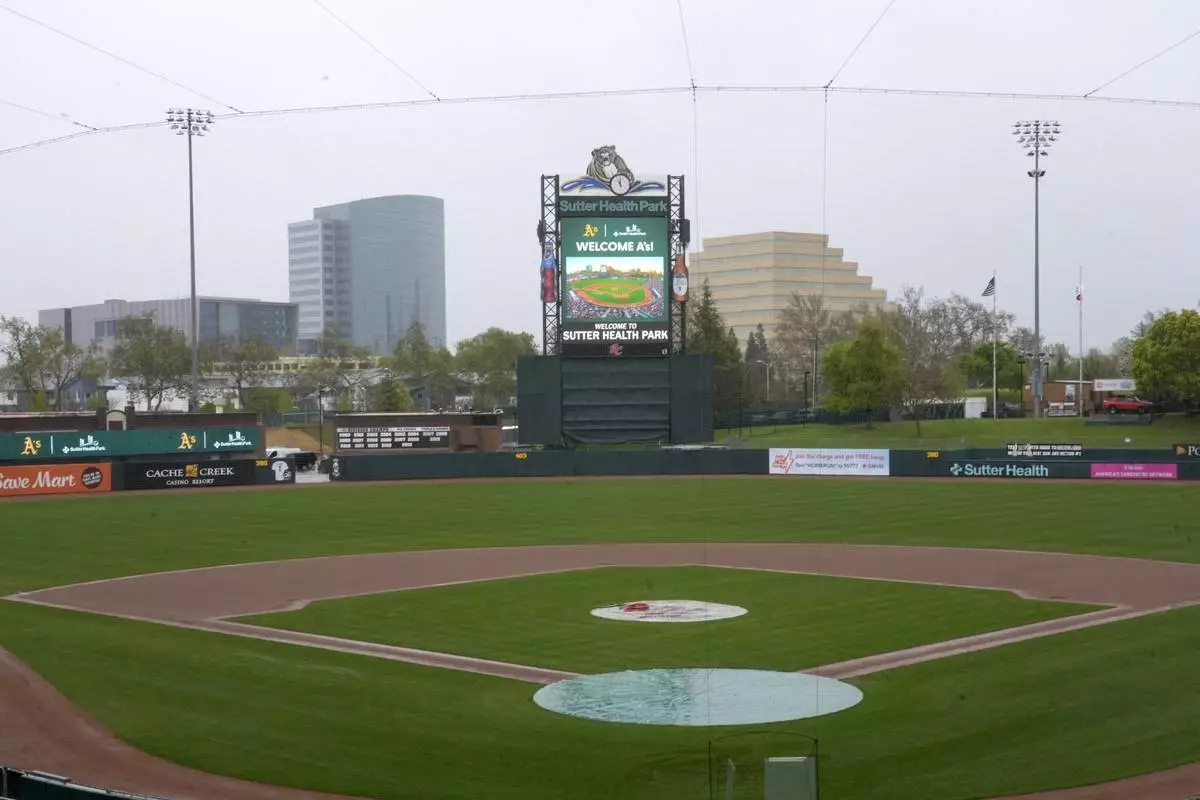
Sutter Health Park, home of the Triple A team Sacramento River Cats, is shown in West Sacramento, Calif., Thursday, April 4, 2024. The Oakland Athletics announced the decision to play at the home of the Sacramento River Cats from 2025-27 with an option for 2028 on Thursday after being unable to reach an agreement to extend their lease in Oakland during that time. (AP Photo/Rich Pedroncelli)

Oakland Athletics manager Mark Kotsay walks to the dugout after making a pitching change during the eighth inning of the team's baseball game against the Cleveland Guardians in Oakland, Calif., Sunday, March 31, 2024. (AP Photo/Jeff Chiu)

















